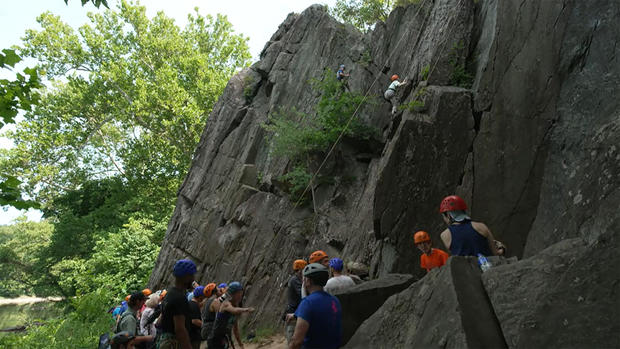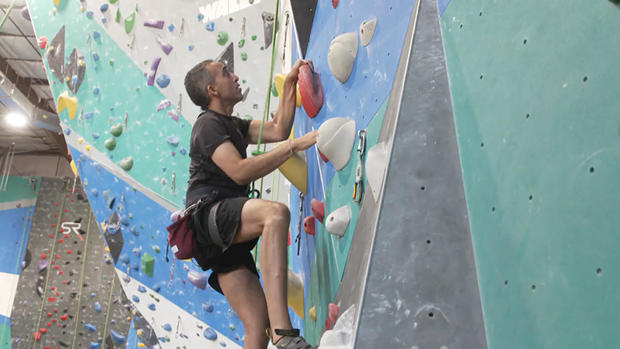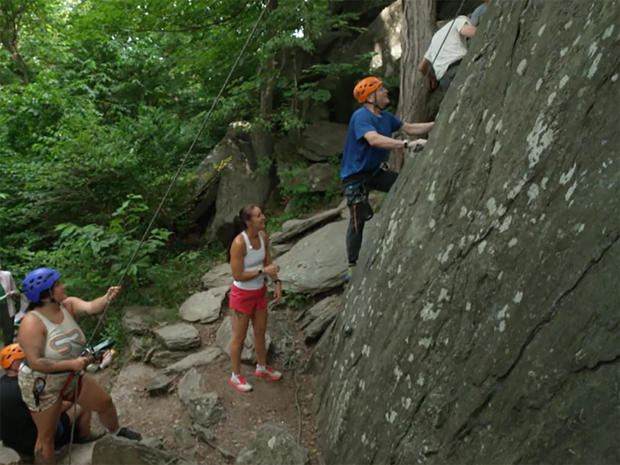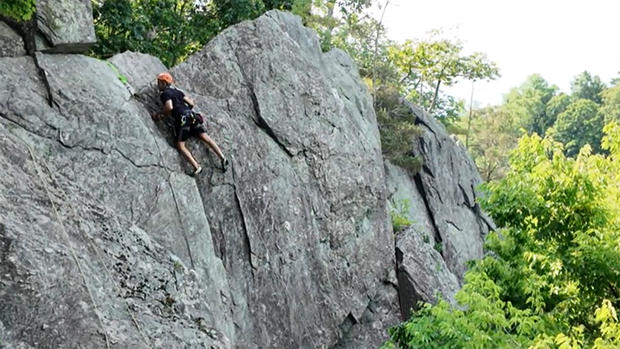
Combating Parkinson’s with rock climbing
We were amazed at what we were seeing on a sweltering summer’s day, when a group of people with Parkinson’s Disease began rock-climbing on the Carderock Cliffs of Maryland. Yes, rock-climbing!
It’s all part of their therapy, says Molly Cupka, the no-nonsense instructor and cheerleader for this community of courageous climbers.
CBS News
She started this program, called UpENDing Parkinsons, as a non-profit twelve years ago.
as he explained on “Sunday Morning” in 2015. “Boxing’s just the opposite of Parkinson’s,” said Latham. “Everything’s designed, instead of to shrink you, everything’s designed to pump you up.”
Boxing program trains patients to beat Parkinson’s
09:41
Jon Lessin said Parkinson’s “makes you feel very small. You make small movements, you’re hunched over. And [rock climbing] makes you feel like you can accomplish the world.”
It was Lessin who first had that big idea to use rock climbing as a therapy for Parkinson’s. “I wanted to do big-movement exercise,” he said. “And I found Molly at this gym.”
Lessin proposed the idea to Molly Cupka, who runs the Sportrock Climbing Center in Alexandria, Virginia. She thought it was worth a try, given the sport requires participants to plan ahead, to know where to position their hands and feet. “I wish I could go into the brain and see what’s happening while people climb,” Cupka said.
Some people with Parkinson’s, like Vivek Puri, get dyskinesia (involuntary jerking motions). Puri said he’s usually unaware of his. He runs a home building company in the D.C. area, and was only 38 when he found out he had Parkinson’s. “Fine motor skills have kind of really suffered dramatically,” he said. “When I don’t climb for some periods of time, I get worse.”
But once he gets on the wall, he calls himself Spider-Man.
CBS News
“Honestly, I climb like a monkey,” he said. “I get my finger strength moving, which gets my fine motor skills – maybe not back, but kind of keeps that in motion.”
There’s no evidence climbing slows the progress of Parkinson’s, but Cupka joined forces with Marymount University last year to study patients climbing for the first time. “We have people literally walking and carrying weights, you know, walking and looking, multitasking,” she said.
The study found that, in so many words, if you climb, you may walk better.
Mark de Mulder, a musician and former director of the National Geospatial Program, doesn’t need a study to prove what climbing does for him. “It allows me to say, ‘All right, take that, Parkinson’s! I’m doing this!’ It just makes me feel stronger, and I’m fighting it. I’m doing something about it.”
CBS News
Many of the climbers have become friends who climb together several times a week; and they’ve become a support group, Parkinson’s Pals, who encourage each other.
“When I reach the top, I can turn around and look and wave, and see my wife and my friends, and that’s the reward,” said de Mulder. “It’s really wonderful.”
There’s no real understanding of how these people can do this, but you can certainly understand why. An emotional Vivek Puri said, “It’s nice to be good at something.”
CBS News
For more info:
Story produced by Richard Buddenhagen and Kay Lim. Editor: George Pozderec.
See also:
Michael J. Fox on Parkinson’s, and maintaining optimism
08:03
More
Source: cbsnews.com



